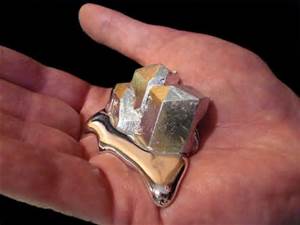Gallium is one of the only elements that melts at room temperature.

Description: Gallium
Image copyright: http://astounde.com/wp-content/uploads/2012/06/gallium.jpg
The physical properties of gallium is that gallium is not found in nature but is obtained by smelting. Gallium expands by 3.1% when it is a solid so it should not be stored in glass. Gallium\'s chemical properties are Atomic number 31, Atomic mass 69.72 g.mol-1, Melting point 85.64, Density 5.1 g.cm-3 at 68 Fahrenheit, boiling point 3999.2, Vanderwaals radius 0.161 nm, Ionic radius 0.083 nm (+3), Isotopes 6, Electronic shell [Ar] 3d10 4s24p1, Enegry of first ionisation 2389kJ.mol-1, Enegry of second iosiation 1978.8 kJ.mol-1, Enegry of third iosisation 2389 kJ.mol-1, Enegry of fourth iosisation 2962.3 kJ.mol-1 Standard potential -0.52 V. It is not possible to find Gallium in the ground it is only found in the +3 oxidation state. Most Gallium is produced as a byproduct of mining other metals including aluminum and zinc.
Some cool facts about Gallium are that it is used in the powerful magnets in computers, solid Gallium will bend like metal if bent slowly but it will break like glass if you bend it fast, and if a person was to put Gallium on aluminium, after a day or two, the aluminium will break up like crackers if hit.
